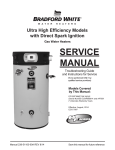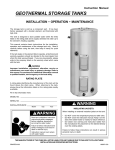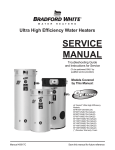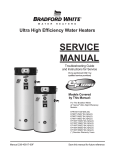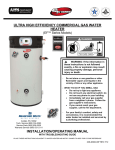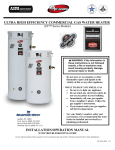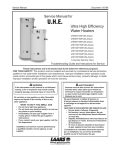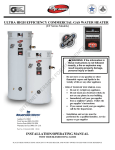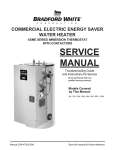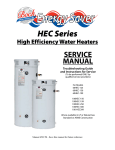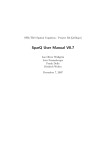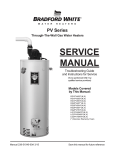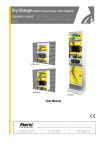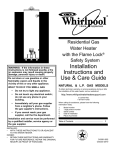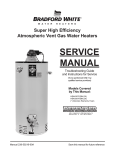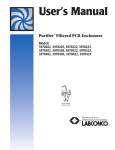Download SERVICE MANUAL - Bradford White
Transcript
Ultra Low NOx Atmospheric Vent Gas Water Heaters SERVICE MANUAL Troubleshooting Guide and Instructions for Service (To be performed ONLY by qualified service providers) Models Covered by This Manual: U65L155E*N (A) U65L199E*N (A) U65L270E*N (A) U100L199E*N (A) U100L270E*N (A) U100L300E*N (A) U100L399E*N (A) (*) Denotes Warranty Years Manual 238-50129-00A Save this manual for future reference The Bradford White Table of Contents Page Service Procedure Introduction 3 --- How to use this manual 4 --- Tool required for service 4 --- Features 5 --- Specifications 6 --- Sequence of Operation 8 --- Troubleshooting 10 --- Thermostat Circuit, Testing & Replacement 27 I Combustion System Testing and Replacement 31 II Burner Tube Inspection & Replacement 35 III Gas Valve Replacement 37 IV Blower Testing and Replacement 38 V Flame Sensor Testing and Replacement 40 VI Spark Rod Replacement 42 VII Ignition Module/Control Board Replacement 43 VIII Transformer Replacement 44 IX Anode Inspection and Replacement 45 X Circulator Assembly Inspection and Replacement 46 XI Blocked Vent Switch Inspection and Replacement 47 XII Damper Inspection and Replacement 48 XIII Heater Service Report 49 --- Parts List 50 --- Glossary of Terms 53 --- 2 2 Introduction The Bradford White Ultra Low NOx Atmospheric Vent Water Heater is designed to deliver a remarkable amount of hot water at 84% efficient in a quiet running unit with a low vent connection that allows for installation existing locations. Several technologically advanced design features are incorporated in the design that will require additional knowledge on the part of the qualified service provider. The information in this manual will instruct service and maintenance professionals on the function, proper diagnosis and repair of The Bradford White Ultra Low NOx Atmospheric Vent Water Heater. The Bradford Ultra Low NOx Atmospheric Vent Water Heater uses a ultra low Nox premix power burner located at the top of the water heater to direct a turbulent flame down into the combustion chamber. This turbulence causes a thorough mixing of gas and air for optimum combustion. The combustion gases then travel through a single pass flue system keeping the gases moving at a high velocity. The combination of high turbulence and velocity results in an optimum transfer of heat from the flue gases into the water. Burner operation is controlled using an electronic ignition module. The module monitors the status of the electronic thermostat, blocked vent limit switch, circulator flow switch, flame sensor to control output voltage to blower motor, spark rod and gas valve. The module contains programming which determines the sequence of operation and timings for purge periods, trial for ignition, flame sensing and lockout. The module will also provide diagnostic information to help in determining the cause of system lockouts. The contents in this manual are detailed informational tools to assist in the proper diagnosis of the Ultra Low NOx Atmospheric Vent Water Heater operational faults. Please read this service manual completely and record as much information regarding the Ultra Low NOx Atmospheric Vent Water Heater operation and installation specifics related to any concerns. 3 3 It is intended for this manual to be used by qualified service personal for the primary purpose of troubleshooting analysis and repair of the Bradford White Ultra Low NOX Atmospheric Vent Water Heater. Understanding the sequence of operation section of this manual will contribute greatly to troubleshooting this product. A “Service Report” is shown towards the end of this manual. Completing this form will assist in the troubleshooting efforts. Should you need to call for technical support, please provide the information shown on this form to the support technician to insure accurate troubleshooting. Troubleshooting begins with “System Observation” to determine failure mode as indicated by the LED status of the ignition module. Troubleshooting continues with “Failure Modes and Probable cause” directing the service provider to a series of test procedures to determine root cause of failure. Component replacement procedures directly follow the test procedures for a given component. Contact Technical support immediately if diagnosis is not determined using the methods described in this service manual. Tools Required for Service Manometer: Two types available, a liquid “U” tube type or a digital (magna-helic) type. This device is used to measure gas and/or air pressures and vacuum. Multi-Meter: A digital type is strongly recommended. This device is used to measure electrical values. The meter you select must have the capability to measure volts AC, volts DC, Amps, micro-amps and ohms. Thermometer: Used to measure water temperature. An accurate thermometer is recommended. Water Pressure Gage: Used to measure water supply pressure. Also used to determine tank pressure by adapting to the drain valve of the heater. Jumper Leads: A length of wire (12" min.) with alligator clip at both ends. Various Hand Tools: Pipe wrench, channel locks, open end wrench set, 12" crescent wrench, Allen wrench set, torx bit set, screw drivers (common & Phillips), long reach (12") magnetic tip Phillips head screw driver #2 tip, ¼" nut driver, pliers (common & needle nose), socket set including a 1-1/16 deep well socket, wire cutters, wire strippers, wire crimpers, torpedo level, small shop sac, step ladder, and flashlight. 4 4 Features of Honeywell Integrated Control System Attractive digital water heater display on control panel for setting and displaying the temperature setpoint. Pressing temperature UP and DOWN buttons changes the temperature setpoint. Same water heater display used on all models. Temperature format may be displayed in °F or °C. Single control board with plug in wiring controls temperature, ignition, and blower operation. Reduced number of parts for servicing and wiring. Plug in wiring reduces chance of miswirng. Burner ignition with direct spark ignition - A high voltage spark jumps from the spark rod to the burner surface to ignite the gas. Eliminates burned out hot surface igniter replacements. Water heater display will show diagnostic codes in the event the water heater needs servicing. Aids in diagnosing and servicing the water heater. Water heater display can show previous error code history to further aid in servicing the water heater. 5 5 Dimensional Layout Model Description Model Number Capacity (GAL) U65L155E3N(A) U65L199E3N(A) U65L270E3N(A) U100L199E3N(A) U100L270E3N(A) U100L300E3N(A) U100L399E3N(A) 65 65 65 100 100 100 100 Input BTU/Hr. NAT. 155,000 199,999 270,000 199,999 270,000 300,000 399,999 1st Hour Delivery at 100°F Rise (Gal.) 203 249 320 274 345 375 477 C B A Floor to Vent Floor to Top of Dia. Vent (in) Cold Water (in.) Conn. (in) 56 ¼ 6 10 ½ 56 ¼ 6 10 ½ 56 ¼ 6 10 ½ 56 ¼ 6 10 ½ 56 ¼ 6 10 ½ 57 ¼ 7 10 ½ 57 ¼ 8 10 ½ D Floor to T& P (in) E Floor to Hot Water Conn. (in) 37 37 37 53 ¼ 53 ¼ 53 ¼ 53 ¼ 39 ½ 39 ½ 39 ½ 55 ¾ 55 ¾ 55 ¾ 55 ¾ F G Water Gas Relief Floor to Floor Conn. Conn. Valve Top of to Gas Dia. Dia. (in.) Water Conn. (in.) (in.) Heater (in) (in) 61 61 61 77 ¼ 77 ¼ 77 ¼ 77 ¼ 58 58 58 74 ½ 74 ½ 74 ½ 74 ½ 1½ 1½ 1½ 1½ 1½ 1½ 1½ ¾ ¾ ¾ ¾ ¾ ¾ 1 ¾ ¾ ¾ ¾ 1 1 1 6 6 Honeywell Integrated Control System Power supply Gas Supply Dedicated 120 VAC, 60 Hz, 15A Minimum ¾”NPT for 300,000 BTU’s/hr. and below. Minimum 1" NPT for 399,999 BTU’s/hr. (schedule 40 black iron pipe recommended) Approved Gas Type Natural gas only. Gas supply must match the gas type listed on the water heater rating label. Gas Pressure (Nat.) 14.0" W.C. maximum static, 4.5" W.C. minimum running (recommend 7.0" W.C. min running) Venting System Atmospherically Vented, Type B venting system or approved chimney. Follow current National Fuel Gas Code requirements or in Canada, the Natural Gas Installation Code. Minimum Clearance for Servicing Maximum Water Supply Pressure 4" from the top, 0" from the front, 4" from the exhaust vent side, 12" from the circulation loop side, 0" from the rear. 150 PSI Thermostat Sensor 11,900 Ohms @ 70°F, ECO opens @ 207°F Max. Redundant sensor for ECO. Sensor inside well for easy replacement of sensor. Control Display Digital display, 24 volts. Temperature Range: 70-180 deg. F. Used to set tank temperature (deg. F or deg. C), show operating status, Display error codes, error code history, limit maximum setpoint temperature. Control Board Operates from 24 volt from transformer. Controls tank temperature, ignition functions, combustion blower. See ignition timings in sequence of operation for Integrated Control. Transformer 120VAC primary, 24VAC secondary, 40VA. Spark Rod Igniter 0.22" nominal gap to the burner surface. Flame Sensor Output Minimum 1 micro amp, Typical range 5 to 30 micro amps. Gas Valve Negative regulation, 24 VAC, ½" PSI max., 4.5" W.C. Minimum running inlet. Blocked Vent Safety Switch Normally closed, opens @ 240°F, manual reset. Circulator Flow Switch 24 VAC, normally open, closes when circulator is operational Blower 120VAC, 60Hz, .6-1 amps, 6400 RPM. Combustion Levels CO2: 10-11%, CO: less then 0.04 percent (400 PPM) air free Circulator 120VAC , 60Hz, .76-1 amps, 3250 PRM 7 7 For models with Honeywell Integrated Control System w/ Direct Spark Ignition 1 Thermostat calls for heat. 2 Combustion blower & circulator start while the damper opens. 3 Blower pre-purge period of 30 seconds. 4 Trial for Ignition. (5 seconds, 3 trials). Flame establishing period (3 seconds), gas valve opens, sparks from spark rod to burner surface to ignite the gas. Burner on, flame proving period (2 seconds). Requires a minimum of 0.8 microamp through flame sense rod to prove flame. If either blocked vent safety switch contacts (normally closed) or circulator flow switch and damper contacts (normally open) remain open after being energized, then the ignition sequence will not start and an error code 29 (Safety switch circuit failed to close or open) will be shown on the display. 5 Steady State Operation: Burner continues to operate until: Thermostat circuit opens, gas valve closes, blower continues to operate for 30 second post-purge period. If the normally closed blocked vent safety switch opens, the gas valve closes, the blower post-purges, then shuts off with error code 26 displayed in a lockout condition. 6 Thermostat satisfied. 7 Gas valve closes, burner extinguished. 8 Blower post purge for 30 seconds. 8 8 For models with Honeywell Integrated Control System w/ Direct Spark Ignition Lockout Conditions (Complete list of error codes is listed on the unit) The system will go into lock out mode for the following reasons: 1. ERROR CODE 26 If the blocked vent safety switch mounted on the draft hood should open, the gas valve will close, the blower will post-purge and error code 26 will appear on the display. The lockout condition will reset once the problem is corrected and the switch reset. Refer to “Vent Safety Switch Testing and Replacement” in this Service Manual. 2. ERROR CODE 29 If the circulator flow switch or the damper contacts fail to open or close in the normal sequence of operation, the gas valve closes, and error code 29 will appear on the control display. When the condition is corrected, the error code will disappear and the water heater will resume normal operation. No resetting of the control display is needed for resetting this error code. 3. ERROR CODE 62 or 63 Control board will go into “Soft Lockout” if the main burner cannot be lit or fails to prove flame after 3 ignition trials. The water heater display indicates a lockout condition by showing an error code number (62 or 63) with “Service Needed” in the control display window. Refer to error codes in the diagnostic section of this Service Manual. In a “Soft Lockout” condition, the control will wait for 60 minutes and then make 3 more attempts to light the main burners. Soft lockout reset is accomplished by depressing the lower right button under “Reset” for 3 seconds. 4. ERROR CODE 65 If the top of the tank should exceed 207°F, then the high limit control will shut off the burner and the water heater will go into a “Hard Lockout”. Error code 65 will be shown in the water heater display. The control can only be reset in the “Service Mode”, which is detailed in the “Troubleshooting” section of this Service Manual. CONNECTION/WIRING DIAGRAM 9 9 System Observation For models with Direct Spark Ignition Water Heater Fault: Water heater does not operate Display Error Code: Water heater display does not operate - blank display WARNING 120 volt potential exposure. Use caution making voltage checks to avoid personal injury. Check main power supply to water heater - fuse, circuit breaker, plug receptacle, line cord or wiring to water heater. Y CAUTION Use caution not to damage connectors when making voltage measurements or jumping terminals Check to make sure switch on front of control panel is in the ON position Y Verify Primary voltage at the control board. N Refer to Control Board illustration. Voltage at primary pins P2(1) & P2(3) will be 110-120. If not, check Line In pins P3(1) & P3(4). Check line cord with volt meter. Replace line cord if defective. Y Verify Secondary voltage at the control board. N Refer to Control Board illustration. Voltage at secondary pins P4(1) & P4(2) will be 24VAC. If not, check transformer. Replace transformer or wire harness. Transformer Top terminals are 24VAC (Blue and Yellow/Green) Bottom terminals are 120VAC (Black and White) CONTROL BOARD Y 3 2 1 1 6 8 2 1 3 5 1 4 2 1 3 5 3 1 3 1 4 J1 Does water heater display operate? Does the combustion blower start to operate? Increase thermostat setting if tank is warm. N Is 24VAC present between RED and BLACK wire pin connections on the back of Control Display? Is 24VAC present between E-COM screw terminals P9(2) & P9(3) on the Control Board. Replace Control Board 10 P4 P9 N P10 P2 Check wires for proper termination to control display. Are wire terminations connected properly to control display? Y N Y Display Operates - See next page P5 P3 Y P7 Replace Control Display. N Y Check wire harness for proper continuity Make proper wire terminations 10 System Observation For models with Direct Spark Ignition WARNING 120 volt potential exposure. Use caution making voltage checks to avoid personal injury. From previous page CAUTION Use caution not to damage connectors when making voltage measurements or jumping terminals Error code #29 on display. Refer to Control Board illustration. Measure voltage between terminals P7(3) & P7(5) on the “inducer” output (make sure the control display shows “heating” in the status mode, if not increase the setpoint). Is there 110-120 VAC? N Does combustion blower operate? Replace control board if display shows “heating” and no voltage is present to the blower harness. Make sure there are no error codes for the temperature sensors (following sections) before replacing control board. N Y Y Replace blower. N Can sparking be seen/heard at the spark rod to the burner? Y N Check the voltage at the connection to the blower. Is 110-120 VAC present? Remove high voltage wire connected at the spark rod and hold approximately ¼" from metal ground with insulated pliers during the ignition cycle (3 second spark trial period). Is there spark to ground? Replace wire harness. N Check resistance of high voltage cable. Resistance should be 0-1 ohms. If resistance is high, replace spark cable. If spark cable is good, replace Control Board. Y Y N Does Main Burner Light? Y Does burner continue until thermostat set point is reached? See setting display in Service Mode and displaying temperature sensors. N Check continuity of spark rod to burner. (see section “Spark Rod Replacement”) Error code #62 on display. See main burner lights, no flame signal in section “Combustion System Testing and Replacement” Check to see if control display shows any other error codes (29, flow or damper switch, 26, vent safety switch, or 65, high limit). If so, refer to the appropriate section for testing and replacement. Error code #63 on display. (see “Combustion System Testing and Replacement”) Y CONTROL BOARD Does blower post-purge for 30 seconds? Y 3 2 1 1 6 8 System okay 1 5 4 2 3 1 2 1 3 5 3 1 3 1 4 J1 P5 P4 P9 P10 P2 P3 P7 11 11 Accessing Service Mode on Control Display For models with Honeywell Integrated Control The display has a “service mode” for changing the maximum setpoint and accessing information in aiding servicing of the water heater. This procedure is for service and installation personnel only. To enter the Service Mode, follow the steps illustrated below: Step 1: Press “Select” and “Temperature Up” buttons together and hold for 3 seconds until “Max Setpoint” is shown in the display. "Max Setpoint" next to Temperature Setpoint value. Max Setpoint idle Status Operational & SELECT SET % Step 2: Pressing “Select” button will change display to next mode °F Water Temp idle Status Operational SELECT SET The following is the sequence of modes available in “Service Mode” by pressing the “Select” button: Error Code Number (Display/Reset). This is only shown if there is an operating error in the “User Mode”. Error Code Shown in Water Heater Display Status Service Needed SELECT Lockout RESET 12 12 Accessing Service Mode on Control Display For models with Honeywell Integrated Control 1. Max Setpoint (Display/Change) Max Setpoint value in Water Heater Display Max Setpoint °F idle Status Operational & SELECT SET 2. Tank Sensor Temperature Displayed Water Temperature Average. °F Water Temp idle Status Operational SELECT SET 3. Flame Current of Burner Flame Sensor (Displays only in the Heating Cycle) A Heating Status Flame Current Operational SELECT SET 13 13 Accessing Service Mode on Control Display For models with Honeywell Integrated Control 4. Setpoint (Display/Change) °F setpoint idle Status Operational SELECT SET 5. °F/°C (Display/Change) °F °F/C° setpoint idle Status Operational SELECT SET 6. Differential (Display only - shows the differential of the thermostat) °F Differential idle Status Operational SELECT SET 14 14 Accessing Service Mode on Control Display For models with Honeywell Integrated Control 7. Software Version (Display only) Soft idle Status Operational & SELECT SET 8. Error Code History (Displays if there are present error codes or up to 10 previous error codes see page 22). Water Heater Display will show a “--“ if there are no error codes. idle Status Operational SELECT SET To change the Maximum Setpoint Limit (Max Setpoint) for the temperature setpoint: Step 1: In service mode press the “Select” button until “Max Setpoint” is displayed. WARNING Setting the water temperature to the maximum set point can result in scalding hot water delivered to the faucets. It is highly recommended that the maximum setpoint be adjusted to the lowest temperature possible for the needs of the installation. Make sure the water heater control display is not in a public area that can result in the temperature settings being improperly adjusted. °F Max Setpoint idle Status Operational & SELECT SET 15 15 Accessing Service Mode on Control Display For models with Honeywell Integrated Control Step 2: Press “Set” button to enter setting mode. “Max Setpoint” will flash to indicate setting mode. "Max Setpoint" Flashes °F Max Setpoint idle Status Operational % SELECT SET Step 3: Press the “UP” or “DOWN” buttons to change the maximum setpoint value. This will limit the maximum setpoint the user can select. Note: The maximum setpoint is approximately 180°F. "Max Setpoint" continues to flash while making adjustments °F Max Setpoint idle Status Operational SELECT SET % Step 4: Press “Set” button to confirm new “Max Setpoint” value and stop setting mode. "Max Setpoint" stops flashing °F Max Setpoint idle Status Operational SELECT 16 % SET 16 Accessing Service Mode on Control Display For models with Honeywell Integrated Control Step 5: 30 Seconds after the last button press, the Water Heater Display will go back to “User Mode”. It will read “Max Setpoint” without showing a temperature value if the temperature setpoint is at the maximum setting. The Water Heater Display can be set back to the “User Mode” immediately by pressing both the “Temperature Up” and “Select” buttons together for 3 seconds. Max Setpoint idle Status Operational & SELECT SET % Exiting Service Mode Display of Water Temperature: Step 1: In Service Mode, Press the “Select” button until “Water Temp” is displayed in the upper right section of the water heater display. This is the reading for the sensor. °F idle Status Operational Lower Sensor & SELECT SET 17 17 Accessing Service Mode on Control Display For models with Honeywell Integrated Control To Display Flame Sense Current of the Pilot Flame Sensor: The pilot flame sense current is available only when the burners are in operation. Step 1: Make sure the status displays “Heating” or draw enough hot water to start the burners. Step 2: Enter the “Service Mode” described previously. Step 3: Press the “Select” button until a number value is displayed with “Flame Current” to the right of the number. The value displayed is in microamps (A). Flame Current A Heating Status Operational SELECT SET To Display and Change Temperature Setpoint: Step 1: In “Service Mode” press the “Select” button until “Setpoint” is shown in the water heater display °F setpoint idle Status Operational SELECT SET 18 18 Accessing Service Mode on Control Display For models with Honeywell Integrated Control Step 2: Press the “Set” button to enter the setting mode. “Setpoint” will flash in the water heater display. °F setpoint idle Status Operational SELECT SET Step 3: To raise the temperature setpoint, press the “Temperature Up” button until the desired temperature is shown on the water heater display. NOTICE The maximum temperature that can be set in the Water Heater Display is limited to the “Max Setpoint” described previously. To change the “Max Setpoint”, refer to the procedure “To Change the Maximum Setpoint Limit…" described previously under “Accessing the Service Mode on the Water Heater Display”. WARNING Setting the water temperature to the maximum set point can result in scalding hot water delivered to the faucets. It is highly recommended that the maximum setpoint be adjusted to the lowest temperature possible for the needs of the installation. Make sure the water heater control display is not in a public area that can result in the temperature settings being improperly adjusted. °F setpoint idle Status Operational SELECT SET % Step 4: To lower the temperature setpoint, press the “Temperature Down” button until the desired temperature is shown on the water heater display. "Setpoint" Flashes °F setpoint idle Status Operational SELECT SET 19 19 Accessing Service Mode on Control Display For models with Honeywell Integrated Control Step 5: When the desired setpoint is reached on the water heater display, press the “Set” button to confirm the new setpoint. “Setpoint” stops flashing in the water heater display. setpoint °F idle Status Operational SELECT SET To Display and Change Temperature Format (°F/°C): To Change Temperature Format in Display from °F to °C or °C to °F: Step 1: While in “Service Mode”, press “Select” button until “°F/°C” is shown in the upper right portion of the water heater display. °F °F/C° idle Status Operational SELECT SET Step 2: Press “Set” button to change temperature format. “°F/°C” symbol will flash in the water heater display. °F °F/C° idle Status Operational SELECT SET 20 20 Accessing Service Mode on Control Display For models with Honeywell Integrated Control Step 3a: Press “Temperature Up” button to change temperature format to °C °C °F/C° idle Status Operational SELECT SET % Step 3b: Press “Temperature Down” button to change temperature format to °F °F °F/C° idle Status Operational SELECT SET Step 4: Press “Set” button to confirm °F or °C format. °F/°C will stop flashing °F °F/C° idle Status Operational SELECT SET 21 21 Accessing Service Mode on Control Display For models with Honeywell Integrated Control Step 5: Pressing “Select” button will return display to setpoint in format selected (°F or °C) immediately °F idle Status Operational Lower Sensor SELECT SET Error Codes and Error History Display: If there is an operating problem with the water heater, an error code number will appear on the water heater display with “Service Needed” to the right of the “Status” indicator. The error code label is located under the Water Heater Display and the following section in this Service Manual explains the error codes with corrective actions to repair the water heater. idle Service Needed SELECT SET Example of Error Code in the Display Error Code History: In “Service Mode” pressing the “Select” button after the “Software Version” (item 8 in the previously described sequence of service modes) will show an error code history, if there have been any previous operating problems with the water heater. If the display shows --, there is not a current error code. The Water Heater Display will provide up to 10 previous error codes. The oldest error code will be stored in code index #1 and the most recent in code index #10. 22 22 Accessing Service Mode on Control Display For models with Honeywell Integrated Control To view previous error codes: Step 1: In “Service Mode press the “Select” button until the next display after the “Software Version”. If there are no current error codes, the display will show -- . °F idle Status Operational SELECT SET Step 2: Press the “Temperature Down” button to select the error code index, starting with the most recent error code “10”. idle Status Operational SELECT SET % Step 3: Press the “Select” button to view the error code for “code 10”. If there is a number displayed, note what the number is. The label next to the water heater display will identify the code number. If no number is displayed with only a “--“ in the water heater display, then there has not been an error code for error code index 10. idle Status Operational SELECT SET 23 23 Accessing Service Mode on Control Display For models with Honeywell Integrated Control Step 4: Press the “Temperature Down” button to change to the previous code index, code #9. idle Status Operational SELECT SET % Step 5: Press the “Select” button for code index #9 to view if there are any code numbers. idle Status Operational SELECT SET Step 6: Continue pressing the “Temperature Down” button to change to the next error code index and press “Select” to view the error code number, if any, for that index number. Continue on to index #1, the oldest error code index. The water heater display will store up to 10 error codes with the oldest code starting in code index #1 with the most recent code in code index #10. Step 7: 10 seconds after the last button press, the Water Heater Display will revert back to the current error code display. To exit Service Mode, either wait 30 seconds or press Temperature Up button and Select Button for 3 seconds. °F setpoint idle Statu s Operational & SELECT SET % Exiting Service Mode 24 24 Error Code Definitions For models with Honeywell Integrated Control ERROR CODE DEFINITIONS If the water heater has an operating problem, there will be a number in the water heater display with “Service Needed” shown below the error code number. Note the error code and the definition in the chart below. This label appears on the control box under the water heater display. The following sections will provide instructions for servicing each error code. HONEYWELL INTERGRATED CONTROL ERROR CODES ERROR CODE DEFINITION 4 LOW FLAME SENSE CURRENT 6 23 FLAME SENSED OUT OF NORMAL SEQUENCE (BEFORE OPENING GAS VALVE OR AFTER CLOSING GAS VALVE) FLAME DETECTED BEFORE IGNITION 24 26 FLAME DETECTED AFTER A HEATING CYCLE COMPLETES BLOCKED VENT SWITCH (OVER 240°F) 29 32 FLOW SWITCH OR DAMPER FAILED TO CLOSE OR OPEN LOWER SENSOR READINGS FAULTY 57 58 FLAME ROD SHORTED TO GROUND AC LINE FREQUENCY ERROR - SIGNAL TOO NOISY OR FREQUENCY INCORRECT 59 61 LINE VOLTAGE TOO LOW OR HIGH DC OUTPUT VOLTAGE UNSTABLE 62 63 MAXIMUM NUMBER OF RETRIES DETECTED MAXIMUM NUMBER OF IGNITION RECYCLES DETECTED 64 65 ELECTRONICS FAILURE HIGH WATER TEMPERATURE (OVER 200°F) IF ANY OF THE ABOVE CODES APPEAR ON THE CONTROL DISPLAY, CONTACT YOUR PLUMBER OR QUALIFIED SERVICE AGENT FOR SERVICE OF THE WATER HEATER. 25 25 Resetting Error Codes For models with Honeywell Integrated Control WARNING The following procedure is for service and installation personnel only. Resetting lockout conditions without correcting the malfunction can result in a hazardous condition. If an error code is displayed (except for #4, low flame sense current), the water heater will be in a “lockout condition” with the water heater display showing the error code number and “Service Needed” in the status section of the display window. Error codes 62 (maximum number of retries detected) and 63 (maximum number if ignition recycles detected) are “Soft Lockouts” in which the control can be reset in the “User Mode” by pressing the lower right button under “Lockout Reset” shown in the lower right portion of the display. The control will also go through 3 attempts to relight the burners every hour in the soft lockout condition. Error Code Shown in Water Heater Display Status Service needed SELECT % Lockout RESET Press for 2 seconds All other error codes will put the water heater into a “Hard Lockout” condition, in which the water heater will not operate and cannot be reset in the “User Mode”. To reset a hard lockout, first enter the “Service Mode” described earlier by pressing both the “Temperature Up” and “Select Buttons” at the same time for 3 seconds. Then press the lower right button under “Lockout Reset” in the water heater display and hold for 3 seconds. Resetting Error Codes in Hard Lockout Condition Error Code Shown in Water Heater Display Status Service Needed & SELECT SET % Step 1: Press for 3 seconds to enter service mode. Status Service Needed SELECT Lockout RESET Step 2: Press for 3 seconds to reset control in service mode. 26 26 WARNING 120 volt potential exposure. Use caution making voltage checks to avoid personal injury. IMPORTANT NOTE: This procedure assumes a cool tank CAUTION Use caution not to damage connectors when making voltage measurements or jumping terminals Condition: Water Heater Not Operating Display shows error code “32” ( Sensor Reading Faulty) Unplug or disconnect electrical power to the water heater Check continuity of wire harness to sensor. Resistance of harness should be close to 0 ohms. Replace wire harness if high resistance is measured (over 0.5 ohms) Check wires for intermittent connections, shorts, frayed insulation. Replace if necessary If wire harness is O.K., check sensor resistance detailed in “Appendix - A: sensor resistance at various temperatures” at the end of the thermostat testing and replacement section. Replace sensor if needed. Turn power ON to water heater. Run water heater through heating cycle and verify proper operation. Sensor temperature can be viewed when burner shuts off (see section on viewing the display in “Service Mode”). Checking continuity of sensor (disconnected at Control Board) Condition: Water Heater Not Operating Display shows error code “65” High Water Temperature (over 200 °F) Sensor shown fully inserted into well WARNING Do not reset the display from the hard lockout state without correcting the cause of the overheating condition Turn power “OFF”. Draw water to cool tank below 120 °F Sensor clip shown installed properly N Check sensor. Sensor is held in place with a clip fastened to the well (see photo). Check sensor wire for potential damage or breaks in the wire insulation. Is the sensor fully inserted into the well? Y If sensor clip is damaged replace clip. Replace sensor if damaged. Continued on next page Check Sensor Resistance (See Sensor Resistance Testing, following section) 27 27 Condition: Water Heater Not Operating Display shows error code “65” High Water Temperature (over 200 °F) (Continued from previous page) WARNING Do not operate water heater without verifying that the overheating condition has been corrected. Once cause of overheating condition has been diagnosed and corrected, the control may be reset Reconnect and switch on power to the water heater. Enter service mode on the water heater display (see illustration) Press button under “Lockout Reset” and hold for 3 seconds. Set thermostat to the desired setting. Water heater will start. Monitor temperatures for one complete heating cycle making sure the maximum tank temperature remains well below 200 °F 28 28 APPENDIX - A Sensor Resistance at Various Temperatures Be Careful When Making Voltage Measurements or Jumping Terminals Not to Damage or Deform Connectors or Connector Pins. Draw Water From The T&P Valve. Compare Temperature With Temperature Ohms Chart Below. Example: If temperature of sensor is 84°F, then the resistance through the sensor would be 8449 (see shaded area). NOTE: Sensor resistance increases as the temperature falls. °F 40 50 60 70 80 90 100 110 120 130 140 150 160 170 180 190 200 0 26109 19906 15314 11884 9299 7333 5827 4663 3758 3048 2488 2043 1688 1402 1170 982 828 1 25400 19383 14925 11592 9078 7165 5697 4562 3679 2986 2439 2004 1656 1376 1150 965 814 2 24712 18876 14548 11308 8862 7000 5570 4464 3602 2925 2391 1966 1625 1351 1129 949 801 3 24045 18383 14180 11032 8653 6839 5446 4368 3527 2866 2344 1928 1595 1327 1110 933 788 In Degrees 4 23399 17905 13823 10763 8449 6683 5326 4274 3453 2808 2298 1891 1566 1303 1090 917 775 F 5 22771 17440 13477 10502 8250 6531 5208 4183 3382 2752 2253 1856 1537 1280 1071 901 762 6 22163 16990 13140 10248 8057 6383 5094 4094 3312 2697 2209 1820 1509 1257 1053 886 749 7 21573 16553 12812 10000 7869 6238 4982 4006 3244 2643 2166 1786 1481 1235 1035 871 737 8 21000 16128 12494 9760 7685 6098 4873 3922 3177 2590 2124 1753 1454 1213 1017 857 725 9 20445 15715 12185 9526 7507 5961 4767 3839 3112 2538 2083 1720 1427 1191 999 842 713 Be Careful When Making Voltage Measurements or Jumping Terminals Not to Damage or Deform Connectors or Connector Pins. 29 29 Thermostat Sensor (Thermister) Replacement Procedure WARNING 120 volt potential exposure. Isolate the appliance and reconfirm power is disconnected using a multi-meter. Step 1. Position main power switch to “OFF” Step 2. Disconnect (unplug) water heater from 120 volt power source. Step 3. Un-latch and remove top surround cover from top of heater. Step 4. Unclip sensor connector from control board and remove harness from control panel (see picture). Step 5. Unclip sensor from well and pull sensor to remove, do not remove well (see picture). Step 6. Install new sensor assembly into well and reinstall senor clip. Step 7. Reconnect the sensor connector to the control board and route the wire harness through the same path that it was removed. Step 8. Restore 120 volt power supply. Confirm proper operation following the lighting instructions on the lighting instruction label or the lighting instruction located in the installation and operating instruction manual. Step 9. Replace surround cover on top of heater. Sensor shown fully inserted into well Remove sensor connector from control board Sensor clip shown installed properly 30 30 Observe burner operation through the sight glass located on the combustion insert mounting flange. Normal burner operation should ignite smoothly, without evidence of coughing or huffing upon ignition. The burner flame should be a blue flame near the burner surface in a uniform flame pattern. Occasional yellow or white streaks are normal. Note: Models using metal fiber mesh burner a red glow from the burner surface is normal. Verify Minimum Gas Supply Piping Requirements of: Minimum ¾" NPT. (Schedule 40 black Iron Pipe recommended). Y N Reconfigure gas supply piping Inadequately sized regulator. N With manometer, check inlet gas pressure. Is it stable N between 7" & 14" W.C. static? (heater not running) (see illustrations at right) Is gas supply pressure regulator adjustable to Y maintain proper and stable setting? Adjust gas supply regulator Venturi adjustment Y WARNING Does inlet gas pressure drop more than 2" W.C. during burner ignition? Inlet gas pressure tap Removing screw from inlet gas pressure tap will immediately allow gas to flow from pressure tap. Y N WARNING 120 volt potential exposure. Use caution making voltage checks to avoid personal injury. Voltmeter set to OHM setting Check resistance of high voltage cable. Resistance should be 0-1 ohms. If resistance is high, replace spark cable. If spark cable is good, replace Control Board. N Can Sparking be seen/ heard at the spark rod to the burner? N Y Remove high voltage wire connected at the spark rod and hold approximately ¼" from metal ground with insulated pliers during the ignition cycle (3 second spark trial period). Is there spark to ground? Y Y Does main burner Light? Y N Check continuity of spark rod. Is reading 0-1 Ohm? N Replace Spark Rod (see “Spark Rod Gap Inspection and Replacement” Spark Rod Volt meter set to OHM setting Meter probe Spark Rod Check spark gap to burner (see “Spark Rod Gap Inspection”) Meter probe Proceed to next page CHECK SPARK ROD RESISTANCE 31 31 Observe burner operation through the sight glass located on the combustion insert mounting flange. Normal burner operation should ignite smoothly, without evidence of coughing or huffing upon ignition. The burner flame should be a blue flame near the burner surface in a uniform flame pattern. Occasional yellow or white streaks are normal. WARNING 120 volt potential exposure. Isolate the appliance and reconfirm power is disconnected using a multi-meter. Continued from previous page Refer to control board illustration, is there 24VAC between P5(5) and P5(8) (blue and brown wires) during the flame establishing period? (Note: Control Display must show “Heating” for operating status) N Replace Control Board Venturi adjustment Y Can you hear or feel gas valve energize? Inlet gas pressure tap Replace Rectifier harness and/or gas valve. (see “Gas Valve Replacement Procedure”) N Y Turn VENTURI set screw clockwise until its bottomed out. Turn screw counter-clockwise 7-½ turns from bottom. (Note: Venturi adjustment screw is not on the U100L399 models) Clear obstruction Inspect burner tube, (see “Burner Tube Inspection”) N N Y Does burner light smoothly, without evidence of coughing or huffing? Check for obstruction at inlet of gas valve. Is inlet free of obstruction? N Y Y CONTROL BOARD Call for technical support Y Does burner stay lit? Does burner operate normaly until thermostat is satisfied? 3 2 1 N 1 6 8 4 2 1 3 5 1 2 1 3 5 3 1 3 1 4 N Y J1 Check flame sensor, Is there 1 to 5 micro amps (min.) during 1.5 second flame proving period? (Value may be displayed on the control display by accessing “Service Mode”) N Y System OK Multimeter set to microamp (A) setting P5 P4 P9 P10 P2 P3 Flame Sense Terminal CHECK FLAME SENSE ROD MICROAMPS Flame Sense Rod Replace flame sensor (see “Flame Sensor Replacement Procedure”) 32 32 P7 WARNING Heater components may be HOT when performing the following steps in this procedure. Take necessary precaution to prevent personal injury. Combustion System Removal Procedure Step 1. Position main power switch to “OFF”. Step 2. Disconnect (unplug) water heater from 120 volt power source. Step 3. Turn off gas supply to water heater. Step 4. Un-latch and remove surround cover from top of heater. Step 5. From the gas valve, disconnect the gas connection, PVC damper assembly, silicone tubing and wire harness. Step 6. Disconnect wire harnesses to the flame sensor, spark rod connection, blower, damper, circulator, flow switch, blocked vent switch and thermostat sensor. Step 7. Remove screws that hold jacket head onto the jacket. Step 8. Remove jacket head with all control panel and all the wire harnesses attached to it. Step 9. Remove the two pieces of insulation that cover access to the burner mounting insert. Step 10. Remove the 4 nuts (7/16" socket) holding the burner assembly in place. Step 11. Carefully remove the combustion system components and gaskets from the water heater. Step 12. See next page for combustion system installation procedure. WARNING 120 volt potential exposure. Isolate the appliance and reconfirm power is disconnected using a multi-meter. Disconnect damper assembly Combustion System Gasket Remove 4 nuts (7/16" socket) 33 33 Combustion System Replacement Procedure Step 1. Fully inspect burner gasket for the following: a) Tears d) Dirt or debris b) Missing material e) Other imperfections that would inhibit proper seal c) Cracks If gasket is NOT affected by any of the above, gasket replacement is not required. Step 2. Install combustion system using new gasket or fully inspected gasket from step 1. Secure the combustion system to the threaded studs using nuts from step 10 on previous page. Tighten the nuts evenly Step 3. Replace the insulation from step 9 from the previous page. If the insulation was damaged in the removal process it needs to be replaced. Step 4. Re-install the jacket head and components that were removed in step 8 from the previous page. Step 5. Reconnect wire harnesses to the flame sensor, spark rod connection, blower, damper, circulator, flow switch, blocked vent switch and thermostat sensor. Step 6. Reconnect PVC damper assembly, gas supply and silicone tubing to gas valve. Turn on gas supply to heater and check for gas leaks, repair any gas leaks found. Step 7. Restore 120 volt power supply to water heater and confirm proper operation following the lighting instructions on the lighting instruction label or the lighting instruction located in the installation and operating instruction manual. Step 8. Replace surround cover on top of water heater. Connect damper assembly after step 5 Combustion System Ensure gasket is in good condition Evenly tighten 4 nuts (7/16" socket) 34 34 WARNING Heater components may be HOT when performing the following steps in this procedure. Take necessary precaution to prevent personal injury. Burner Tube Removal Procedure Step 1. Position main power switch to “OFF”. Step 2. Disconnect (unplug) water heater from 120 volt power source. Step 3. Turn off gas supply to water heater. Step 4. Un-latch & remove surround cover from top of heater. Step 5. From the gas valve, disconnect the gas connection, PVC damper assembly, silicone tubing and wire harness. Step 6. Disconnect wire harnesses to the flame sensor, spark rod connection, blower, damper, circulator, flow switch, blocked vent switch and thermostat sensor. Step 7. Remove screws that hold jacket head onto the jacket. Step 8. Remove jacket head with all control panel and all the wire harnesses attached to it. Step 9. Remove the two pieces of insulation that cover access to the burner mounting insert. Step 10. Remove the 4 screws (philips head) that hold the Spark Rod and Flame Sensor. Step 11. Remove the Spark Rod and Flame Sensor. The gaskets will need to be replace when reinstalled. Step 12. Remove the 6 nuts (7/16" socket) holding the burner plate and combustion system in place. Step 13. Remover combustion system and burner plate from the mounting assembly. See next page for burner tube installation procedure. WARNING 120 volt potential exposure. Isolate the appliance and reconfirm power is disconnected using a multi-meter. Combustion system and burner plate Spark Rod and Flame Sense Burner Burner Gasket (X2) Remove 6 nuts (7/16" socket) Mounting Assembly 35 35 WARNING Heater components may be HOT when performing the following steps in this procedure. Take necessary precaution to prevent personal injury. Burner Tube Inspection Step 1. a) Outer fiber mesh should be uniform with no tears or deterioration. b) Gently squeeze burner tube, Burner tube should feel firm without any soft areas around the sides or at the bottom. c) Visually inspect inside burner tube, Burner tube should be intact with no areas of deterioration. Ports should be free of any debris. Step 2. If burner tube is affected by any of the above, replacement is required. Refer to burner tube replacement procedure below. Burner Tube Replacement Procedure Step 1. Fully inspect burner flange gaskets, igniter and flame sensor gaskets for the following: a) Tears d) Dirt or debris b) Missing material e) Other imperfections that would inhibit proper seal c) Cracks If gaskets are NOT affected by any of the above, gasket replacement is not required. Step 2. Install burner tube with gaskets into mounting assembly. Be sure gasket surfaces are free of debris. Step 3. Reinstall the burner plate with combustion assembly with the nuts that were removed from step 12 on previous page. Tighten the nuts evenly. Step 4. Carefully reinstall flame sensor with gasket and direct spark igniter (DSI) with gasket and secure with screws from step 11 on previous page. . Step 5. Replace the insulation from step 9 form the previous page. If the insulation was damaged in the removal process it needs to be replaced. Step 6. Re-install the jacket head and components that were removed in step 8 from the previous page. Step 7. Reconnect wire harnesses to the flame sensor, spark rod connection, blower, damper, circulator, flow switch, blocked vent switch and thermostat sensor. Step 8. Reconnect PVC damper assembly, gas supply and silicone tubing to gas valve. Turn on gas supply to heater and check for gas leaks, repair any gas leaks found. Step 9. Restore 120 volt power supply to water heater and confirm proper operation following the lighting instructions on the lighting instruction label or the lighting instruction located in the installation and operating instruction manual. Step 10. Replace surround cover on top of water heater. 36 36 Gas Valve Replacement Procedure Step 1. Position main power switch to “OFF”. Step 2. Disconnect (unplug) water heater from 120 volt power source. Step 3. Turn off gas supply to water heater. Step 4. Un-latch & remove surround cover from top of heater. Step 5. From the gas valve, disconnect the gas connection, PVC damper assembly, silicone tubing and wire harness. Step 6. Remove the 2 gas valve mounting screws (Torx bit) located at the 11:00 O-clock & 5:00 O-clock position on the venturi mounting flange and remove gas valve from water heater. Step 7. Remove any residual gasket material from blower and venturi mounting flange. WARNING 120 volt potential exposure. Isolate the appliance and reconfirm power is disconnected using a multi-meter. Blower Gas valve assembly Gas valve mounting screws (X2) Venturi mounting flange Blower / gas valve gasket Step 8. Install new gas valve with new gasket provided. Secure gas valve in place using screws from step 6. Step 9. Reconnect PVC damper assembly, gas supply, wire harness and silicone tubing to gas valve. Turn on gas supply to heater and check for gas leaks, repair any gas leaks found. Step 10. Restore 120 volt power supply to water heater and confirm proper operation following the lighting instructions on the lighting instruction label or the lighting instruction located in the installation and operating instruction manual. Step 11. Replace surround cover on top of water heater. 37 37 Is there 120VAC across the white and black wires at location P3 on the control board ? (see photo at bottom) Does blower energize? Y (For Direct Spark Ignition models, ensure control display shows “Heating”, raise temperature setpoint if necessary) Refer to ignition module/control board illustration. Is there 120VAC between P7(5) and P7(3)? Y N Y Black wire leading to control board from power switch looped through amprobe. N Determine power source problem and correct Is there 120VAC across the top white and bottom black wire at the power switch ? Check amp draw through BLACK wire lead from power switch to control board. Is there .6 to 3.0 amps? N Replace ignition module/ control board. N Is Blower wheel secured to Y blower motor shaft? Y Call technical support. N Y N Replace blower. (see “Blower Replacement Procedure”) Refer to ignition module/ control board illustration. Is there 120VAC between P7(5) and P7(3)? N Is the blocked vent switch in the normal closed position? Y Is the flow switch in the closed position? N Is there 120VAC across the white and black wires at the blower? (see photo at right) N Correct safety circuit problem per safety circuit trace (section “Blocked Vent Safety Switch Testing”). Y N Y Is the damper in the open position? Y Replace ignition module/control board. N Correct safety circuit problem per safety circuit trace (section “Flow Switch Testing”). Inspect Damper (section “Damper Testing”). Checking for 120VAC (Black & White Wires) Repair/replace wire harness. Y Replace blower. (see “Blower Replacement Procedure”) CONTROL BOARD 3 2 1 1 6 8 4 2 1 3 5 1 2 1 3 5 3 1 3 1 4 J1 P5 P4 P9 P10 P2 P3 DIRECT SPARK IGNITION MODELS 38 P7 38 Blower Replacement Procedure WARNING 120 volt potential exposure. Isolate the appliance and reconfirm power is disconnected using a multi-meter. Step 1. Position main power switch to “OFF”. Step 2. Disconnect (unplug) water heater from 120 volt power source. Step 3. Turn off gas supply to water heater. Step 4. Un-latch & remove surround cover from top of heater. Step 5. From the gas valve, disconnect the gas connection, PVC damper assembly, silicone tubing and wire harness. Disconnect wire harness from blower. Step 6. Step 7. Remove the 2 gas valve mounting screws (Torx bit T-25 or 5/32 Allen wrench) located at the 11:00 O-clock & 5:00 O-clock position on the venturi mounting flange. Step 8. Remove 4 blower flange mounting screws (5/32 Allen wrench) and remove blower from transition flange. Blower / gas valve gasket Blower Gas valve assembly Blower transition gasket Blower transition Blower mounting screws (X4) Step 9. Remove any residual gasket material from venturi mounting flange and transition flange. Step 10. Install new blower with new gasket provided. Secure blower in place using screws from step 8. Step 11. Reconnect gas valve assembly to blower with new gasket provided. Secure gas valve in place using screws from step 7. Gas valve mounting screws (X2) Step 12. Reconnect PVC damper assembly, gas supply and silicone tubing to gas valve. Turn on gas supply to heater and check for gas leaks, repair any gas leaks found. Step 13. Reconnect wire harnesses to blower assembly and gas valve, restore 120 volt power supply to water heater and confirm proper operation following the lighting instructions on the lighting instruction label or the lighting instructions located in the installation and operating instruction manual. Step 14. Replace surround cover on top of water heater. 39 39 WARNING Flame Sensor Testing Procedure Refer to illustration below, is there a minimum of 1 micro amp during 1.5 second flame proving period? 120 volt potential exposure. Use caution making voltage checks to avoid personal injury. Flame sensor may be too hot to handle, take necessary precautions Refer to ignition module/control board illustration.(24 volts should maintain beyond the 1.5 second flame proving period.) Is there 24VAC between P5(5) and P5(8)? Y Y Flame sensing circuit OK N N With flame sensor Disconnected from ignition module, check continuity to ground. Is there continuity to ground? Replace flame sensor with gasket and/or wire lead. (see “Flame Sensor Replacement Procedure”) Y Call for technical support N Remove flame sensor from water heater. Check continuity from tip of flame sensor to end of wire lead. Is there continuity? N Y N Is flame sensor free of oxidation? Y Is ceramic of flame sensor cracked? Y Replace flame sensor. (see “Flame Sensor Replacement Procedure”) N Clean or replace flame sensor. (see “Flame Sensor Replacement Procedure”) Volt meter set to Micro amps setting (ђA) CONTROL BOARD 3 2 1 Meter probe 1 6 8 1 5 4 2 3 1 2 1 3 5 3 1 3 1 4 Flame sensor terminal J1 Flame sensor terminal on control board. DIRECT SPARK IGNITION MODELS 40 P5 P4 P9 P10 P2 P3 P7 Meter probe 40 Flame Sensor Replacement Procedure WARNING 120 volt potential exposure. Isolate the appliance and reconfirm power is disconnected using a multi-meter. Step 1. Position main power switch to “OFF” Step 2. Disconnect (unplug) water heater from 120 volt power source. Step 3. Un-latch & remove surround cover from top of heater. Step 4. Carefully cut a path in the insulation from the blower tube towards the flame sensor (shown below). Pay close attention to not cut any wires. Fold the insulation back to expose the flame sensor. Step 5. Disconnect wire lead from flame sensor. Step 6. Remove the 2 sensor mounting screws (magnetic tip, long reach Phillips screw driver) and remove flame sensor & gasket from transition base flange. Blower tube Cut insulation Step 7. Remove any residual gasket material from transition base flange. Step 8. Install new flame sensor with new gasket provided using screws from step 6. Arrange flame sensor with hook towards burner. Step 9. Reconnect flame sensor wire. Step 10. Fold insulation back into place. Be sure no wires are under the insulation that could come in contact with burner flange. Step 11. Restore 120 volt power supply to water heater and confirm proper operation following the lighting instructions on the lighting instruction label or the lighting instructions located in the installation and operating instruction manual. Step 12. Replace surround cover on top of water heater. Flame sensor Flame sensor screws (X2) Flame sensor gasket Flame senor 41 41 Spark Rod Replacement Procedure WARNING 120 volt potential exposure. Isolate the appliance and reconfirm power is disconnected using a multi-meter. Step 1. Position main power switch to “OFF” Step 2. Disconnect (unplug) water heater from 120 volt power source. Step 3. Un-latch & remove surround cover from top of heater. Step 4. Carefully cut a path in the insulation from the blower tube towards the flame sensor (shown below). Pay close attention to not cut any wires. Fold the insulation back to expose the spark rod. Step 5. Disconnect wire lead from spark rod. Step 6. Remove the 2 mounting screws (magnetic tip, long reach Phillips screw driver) and remove spark rod & gasket from transition base flange. Step 7. Remove any residual gasket material from transition base flange. Step 8. Install new spark rod with new gasket provided using screws from step 6. Arrange spark rod with hook towards burner (Offcenter mounting hole only allow installation one way). Check distance between spark rod and blower transition tube (shown below). Step 9. Step 10. Step 11. Cut insulation Spark Rod Fold insulation back into place. Be sure no wires are under the insulation that could come in contact with burner flange. Restore 120 volt power supply to water heater and confirm proper operation following the lighting instructions on the lighting instruction label or the lighting instructions located in the installation and operating instruction manual. Off-center mounting hole Replace surround cover on top of water heater. Distance of 2" to 2 1/16" for 199,999 input and below. Distance of 4 1/8" to 4 3/16" for 270,000 input and above. Spark rod screws (X2) Spark rod gasket Center of spark rod Spark rod Blower transition tube 42 42 Control Board Replacement Step 1. Position main power switch to “OFF” Step 2. Disconnect (unplug) water heater from 120 volt power source. Step 3. Un-latch and remove top surround cover from top of water heater. Step 4. Locate control board. Step 5. Remove 4 screws that attach display panel to control panel (save screws). Step 6. Carefully disconnect all wire connections from control board (Identify all wire connections) Step 7. Depress tabs on the top of control first then tilt the control forward. Step 8. Unhook the tabs on the control out of the slots on the control panel and remove control. Step 9. Replace control board and all wire connections. Step 10. Re-attach the display panel from step 5 using the same screws. Step 11. Restore 120 volt power supply to water heater and confirm proper operation following the lighting instructions on the lighting instruction label or the lighting instruction located in the installation and operating instruction manual. Step 12. Replace surround cover on top of water heater. WARNING 120 volt potential exposure. Isolate the appliance and reconfirm power is disconnected using a multi-meter. Remove Screws (X4) Display panel Unclip this side first Control Board Unclip this side second Identify wires for proper re-connection 43 43 Transformer Replacement Procedure Step 1. Position main power switch to “OFF” Step 2. Disconnect (unplug) water heater from 120 volt power source. Step 3. Un-latch and remove top surround cover from top of water heater. Step 4. Disconnect primary leads (black & white) and secondary leads (blue & yellow) from the transformer. (leads are different sizes to prevent interchanging) Step 5. Remove the 2 screws ( short Phillips screw driver) holding the transformer in place and remove transformer from control panel. (see photo right) Step 6. Install new transformer and secure in place with screws from step 5. Step 8. Reconnect primary and secondary wires to transformer (leads are different sizes to prevent interchanging). Step 9. Restore 120 volt power supply to water heater and confirm proper operation following the lighting instructions on the lighting instruction label or the lighting instruction located in the installation and operating instruction manual. Step 10. Replace surround cover on top of water heater. WARNING 120 volt potential exposure. Isolate the appliance and reconfirm power is disconnected using a multi-meter. Step 4 Remove wires to transformer Step 5 Remove transformer mounting screws 44 44 Anode inspection and replacement WARNING Heater components and stored water may be HOT when performing the following steps in this procedure. Take necessary precaution to prevent personal injury. Step 1. Position main power switch to “OFF” Step 2. Disconnect (unplug) water heater from 120 volt power source. Step 3. Turn off water supply and drain water heater. Step 4. Locate (see photo below) and remove anode rods from heater (1-1/16 hex socket). U65L has 3 anodes (2 front and 1 side) and U100L 5 anodes (3 front and 2 side). Step 5. Visually inspect anode rod. Anode rod should show signs of depletion, this is normal. If the depletion is ½ of the original diameter (approximately ¾" diameter), replacement is recommended. If any of the steel core of the anode is exposed, replacement is recommended. Step 6. Upon completion of inspection or subsequent replacement, apply thread sealing tape or other thread compound to threads of anode and reinstall into heater. Restore water supply and check for and repair any leaks found. Step 7. Restore 120 volts to water heater and verify proper heater operation following the instructions on the lighting instruction label or the lighting instruction located in the installation and operating instruction manual. Front of water heater. Anodes located under plastic covers between inlet and outlet water connections. Side of water heater. Anodes located under plastic covers behind the circulator assembly. Circulator will need to be disconnected to get to anodes locations. Refer to circulator assembly replacement procedure. 45 45 Step 1. When Error Code 29 is present you first must determine if the circulator or flow switch is bad. Step 2. Check if there is 120V to the circulator harness (see picture below). If voltage is not present trace wire harness for any sign of damage. Replace harness if damaged. If voltage is present replace circulator see step 5. Step 3. Check if the flow switch is working properly (see picture below). Using a volt meter check the continuity between top and bottom screw terminals on the flow switch. If the circulator is flowing water there will be continuity. Step 4. If there in no continuity present gently push down the flow switch lever down to make continuity. If continuity is made recheck to see if the circulator is bad. If continuity is not made replace the flow switch see step 5. Step 5. Position main power switch to “OFF” Step 6. Disconnect (unplug) water heater from 120 volt power source. Step 7. Turn off water supply and drain water heater. Step 8. Once the water heater is drained remove the cable ties holding on the pipe insulation. Save the pipe insulation to replace after repair is made. Step 9. Disconnect and replace either the flow switch and/or circulator assembly. Step 10. During replacement of the components, apply thread sealing tape or other thread compound to threads of the flow switch or circulator assembly onto heater. Restore water supply and check for and repair any leaks found. Circulator (120V) Flow Switch Step 11. . Step 12. Replace pipe insulation from step 8. Check voltage of bottom to connections with volt meter Check continuity between top and bottom screws Remove cover from flow switch Restore 120 volt power supply to water heater and confirm proper operation following the lighting instructions on the lighting instruction label or the lighting instruction located in the installation and operating instruction manual. Gently pull the lever up to break continuity or push the lever down to make continuity 46 46 Step 1. First determine is the “Blocked Vent Switch” was installed correctly on the drafthood (see picture right). Step 2. When Error Code 26 is present you first must determine if there is a blocked vent condition present. If so, clear the obstruction and reset the switch then continue with normal operation. Step 3. If the switch is tripped and there is no obstruction in the venting there could have been an extended down draft that tripped the switch. The down draft could have been caused by damage vent termination. Contact your plumbing professional to correct this issue. Step 4. When no blockage or downdraft issues are present check the continuity of the switch (see photo below). If there is no continuity present even when switch is reset the blocked vent switch assembly needs to be replaced. Step 5. If blocked vent switch assembly is functioning correctly check to see if the wire harness has any signs of damage. Replace harness if any signs of damage exist. Step 6. Restore water heater to use and confirm proper operation following the lighting instructions on the lighting instruction label or the lighting instruction located in the installation and operating instruction manual. Blocked Vent Switch should be installed on the lip of the drafthood Set voltmeter to Ohms setting. The switch should be very close to 0 ohms 47 47 Step 1. Un-latch and remove top surround cover from top of water heater. Step 2. Locate the damper at the back of the units. If the damper is working properly intake air should be pulling in through the screened elbow (see picture right). Step 3. Verify that the damper is in the “Open” position when there is a call for heat (see picture below). If you hear the blower on but damper is not open turn the power switch off for 30 seconds and recheck to see if damper opens. If the damper doesn’t open replace it. Step 4. Check for voltage at the damper harness connection. Use a volt meter set to read line voltage (see picture below). There should always be 102 to 132 volts between black and white wires. There should also be 102 to 132 volts between blue and white wires when there is a call for heat. Step 5. If 120 volts is not present from either two inspection points check the harnesses for damage and replace if needed. Step 6. Restore water heater to use and confirm proper operation following the lighting instructions on the lighting instruction label or the lighting instruction located in the installation and operating instruction manual. Step 10. WARNING 120 volt potential exposure. Isolate the appliance and reconfirm power is disconnected using a multi-meter. 120 Volt Intake Damper Air Flow Replace surround cover on top of water heater. Remove screw for elbow removal Damper in open position Voltmeter set to voltage Screened elbow removed to see damper position Check for voltage at damper harness from control board. 48 48 Date Service Provider Model Number Phone Number Serial Number Venting: Vent 6", 7" or 8" Horizontal length Vertical length Gas Line: Gas Pressure: Venturi: Size & material Static Setting from Bottom in Turns Distance from meter to water heater Running Inlet Manifold Electrical: Line Voltage Low Voltage Spark Rod Resistance: Flame Sense Micro -Amps: Polarity Flame Sense Resistance:___________ Error Codes on Control Display (Direct Spark Ignition): __________________________________ Combustion: CO2 Installation Site Name & Address: CO Installation Site Contact Name & Phone Number 49 49 U Model – Water Heater 1 Surround Assembly Combustion Assembly 2 (Specify model) 3 Ignition Control Assembly 4 Draft Hood (Specify model) 5 Vent Vertical Tube 6 Vent Protector Assembly 7 Baffle 3” Flue (Specify Model) 8 Damper Bracket (Specify Model) 9 Thermostat Sensor 10 Utility Cover 11 Circulator Assembly 12 ¾” NPT Nipple 13 Stainless Flex Connector 14 NPT/SAE Adapter 15 T&P (Specify Model) 16 Hot Water Outlet Plastisert Nipple 17 Anode 18 Cold Water Inlet (Hydrojet) Assembly 19 Plastic Hole Closure 20 No Handle Brass Drain Valve 21 Screw 5/16-18 x 3/4” HH Grade 5 Cleanout Access Cover 22 (Specify Model) 23 Cleanout Cover 24 Stainless Exhaust Boot 25 Cleanout Gasket (Specify Model) 26 Service Panel Cover 27 Blocked Vent Switch Customer must specify complete model number and serial number when ordering service parts. 50 50 Combustion Assembly 1 2 3 4 5 6 7 8 9 10 11 12 13 Combustion Assembly (Specify model) Blower/Gas Valve Assembly (Specify model) Burner Assembly (Specify model) Blower – (Specify model) Damper Assembly (Specify Model) Transition Tube Gasket Blower Transition Gasket Transition Tube 1/4 – 20 Nut Screw 8-32 x ¼” RHCR Gasket Flame Sense Gasket Igniter Sensor – Flame Sense 14 Igniter – Direct Spark Ignition 15 16 17 18 19 20 Blower / Burner Mounting Plate Gasket Burner (Specify Model) Burner (Specify Model) Burner Mount Assembly Sight Glass Assembly Gasket Sight Glass Customer must specify complete model number and serial number when ordering service parts. 51 51 Ignition Control Assembly and Harnesses 1 2 3 4 5 6 7 8 9 10 Control Panel Control Transformer Display Panel Screw Switch Main Power Control Display Screw Blower/Circ/Damper Harness (24V) Damper Harness (120V) 11 12 13 14 15 16 17 18 Controller Harness (24V) Power Cord Harness (120V) Blocked Vent Switch Harness (24V) T-Stat Harness (24V) Control Display Harness (24V) Blower Harness (120V) Circ/Flow Harness (120V) BVS/Damper/Flow Harness (24V) 19 Ignition Harness (Direct Spark Ignition) 20 Flame Sense Harness Customer must specify complete model number and serial number when ordering service parts. 52 52 AC BTU/H CO CO2 DC DSI ECO GFI GPM HSI Hz LED NOx NPT PSI RPM VA VAC W.C. °C °F A Alternating Current British Thermal Units Carbon Monoxide Carbon Dioxide Direct Current Direct Spark Ignition Energy Cut Off Ground fault interrupt Gallons per Minute Hot Surface Igniter Hertz Light Emitting Diode Oxides of Nitrogen National Pipe Thread Pounds per Square Inch Revolutions per Minute Volt Amps Volts Alternating Current Inches of Water Column Degrees Centigrade Degrees Fahrenheit Micro Amp NOTES 53 53 NOTES 54 54 NOTES 55 55


























































